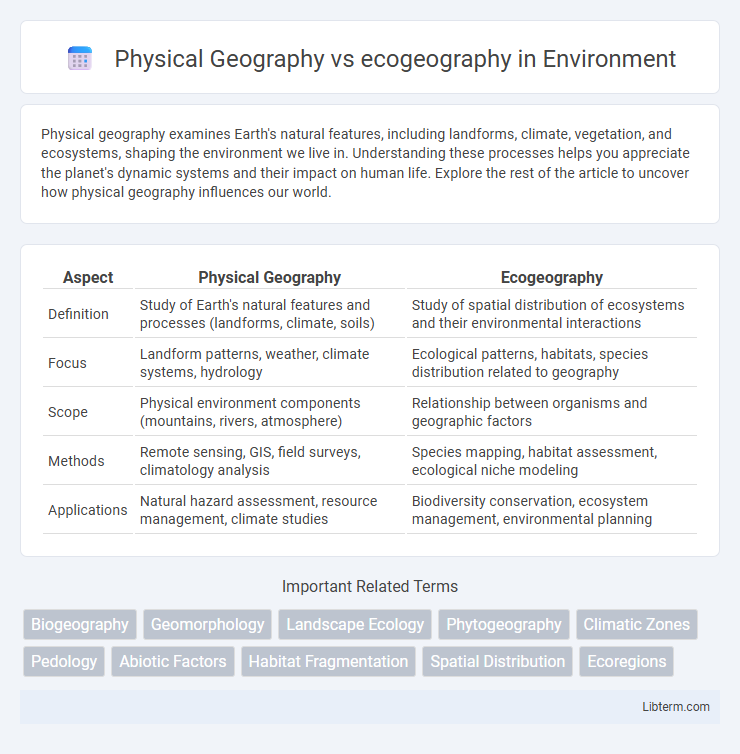Physical geography examines Earth's natural features, including landforms, climate, vegetation, and ecosystems, shaping the environment we live in. Understanding these processes helps you appreciate the planet's dynamic systems and their impact on human life. Explore the rest of the article to uncover how physical geography influences our world.
Table of Comparison
| Aspect | Physical Geography | Ecogeography |
|---|---|---|
| Definition | Study of Earth's natural features and processes (landforms, climate, soils) | Study of spatial distribution of ecosystems and their environmental interactions |
| Focus | Landform patterns, weather, climate systems, hydrology | Ecological patterns, habitats, species distribution related to geography |
| Scope | Physical environment components (mountains, rivers, atmosphere) | Relationship between organisms and geographic factors |
| Methods | Remote sensing, GIS, field surveys, climatology analysis | Species mapping, habitat assessment, ecological niche modeling |
| Applications | Natural hazard assessment, resource management, climate studies | Biodiversity conservation, ecosystem management, environmental planning |
Introduction to Physical Geography and Ecogeography
Physical geography studies Earth's natural features including landforms, climate, soils, and vegetation patterns to understand environmental processes and spatial patterns. Ecogeography combines ecological principles with geographic analysis to examine the interactions between organisms and their physical environments across spatial scales. The introduction to physical geography emphasizes earth system components, while ecogeography focuses on the spatial distribution and ecological relationships of organisms within these physical settings.
Defining Physical Geography: Scope and Focus
Physical geography studies Earth's natural features and processes, including landforms, climate, vegetation, and hydrology, emphasizing spatial patterns and physical phenomena. It analyzes the environment's physical components to understand dynamics like weather systems, geological formations, and ecosystems. Ecogeography, a subfield, integrates biological and ecological factors, focusing on spatial relationships between organisms and their physical habitats.
Core Concepts in Ecogeography
Physical geography examines natural Earth processes such as landforms, climate, and ecosystems, while ecogeography focuses on the spatial distribution of organisms in relation to environmental factors. Core concepts in ecogeography include biogeographical patterns, habitat specificity, and ecological niches, emphasizing how abiotic components like temperature, soil, and moisture influence species distribution. Understanding these concepts aids in analyzing biodiversity hotspots, species migration, and ecosystem dynamics under changing environmental conditions.
Key Differences Between Physical Geography and Ecogeography
Physical geography studies natural features and processes of the Earth, including landforms, climate, and ecosystems, focusing on spatial patterns and physical phenomena. Ecogeography examines the distribution of organisms in relation to environmental factors, emphasizing interactions between species and their habitats. Key differences lie in physical geography's emphasis on abiotic components and landscape processes, whereas ecogeography integrates biotic interactions and ecological principles to understand species distribution.
Research Methods in Physical Geography
Research methods in physical geography primarily involve quantitative data collection techniques such as remote sensing, GIS mapping, and spatial analysis to study landforms, climate patterns, and hydrological processes. Ecogeography, while overlapping with physical geography, incorporates more interdisciplinary approaches including ecological surveying and biodiversity assessments to understand the spatial distribution of organisms in relation to environmental factors. Both fields utilize field sampling, modeling, and statistical tools to analyze physical environment interactions but differ in their emphasis on abiotic versus biotic components.
Ecogeographical Approaches and Methodologies
Ecogeographical approaches integrate ecological principles with geographical patterns, emphasizing the spatial distribution of organisms in relation to environmental factors. Methodologies often involve GIS mapping, remote sensing, and spatial statistics to analyze habitat connectivity, species distribution, and environmental gradients. This interdisciplinary framework enhances understanding of biogeographical processes and supports conservation planning by linking ecological dynamics with physical landscape features.
Importance of Spatial Scale in Both Disciplines
Spatial scale critically influences both Physical Geography and Ecogeography by determining the resolution at which environmental patterns and processes are analyzed. Physical Geography examines landforms, climate, and hydrological cycles at local to global scales, while Ecogeography investigates species distributions and ecosystem interactions across micro to macro spatial scales. Understanding spatial scale enhances the accuracy of modeling natural phenomena and biodiversity patterns, allowing for more effective environmental management and conservation strategies.
Applications in Environmental Management and Planning
Physical geography provides critical data on landforms, climate, and hydrology essential for environmental management, enabling accurate risk assessments and resource allocation. Ecogeography integrates ecological patterns with geographic information, supporting biodiversity conservation and habitat restoration by identifying ecological corridors and vulnerable species distributions. Combining these disciplines enhances spatial planning and sustainable development strategies through precise environmental impact analyses and ecosystem service evaluations.
Challenges and Limitations in Both Fields
Physical geography faces challenges in accurately modeling complex natural systems due to spatial and temporal variability as well as limited data resolution. Ecogeography encounters limitations in integrating biological and physical data, which complicates understanding species distributions under changing environmental conditions. Both fields struggle with scale issues and the unpredictability of human impact on natural processes, hindering precise forecasting and effective management strategies.
Future Trends in Physical Geography and Ecogeography
Future trends in physical geography emphasize the integration of advanced remote sensing technologies and machine learning for precise environmental monitoring. Ecogeography is evolving with a strong focus on climate change impacts, biodiversity conservation, and spatial analysis of ecosystem services. Both fields increasingly converge in using big data analytics and geographic information systems (GIS) to model and predict environmental and ecological changes at global and regional scales.
Physical Geography Infographic

 libterm.com
libterm.com